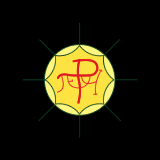
|
Perun's Weapons
Perun's bow is sometimes identified with the rainbow, from it, are shot burning arrows, which set on fire all things that they touch. Perun's lightning bolts were believed to be stones and stone arrows. These thunderbolt stones were sometimes said to be transferred back to the sky by the wind after being passed through the earth to a certain depth and return gradually to the surface in a specific period of time - usually 7 yrs 40days. When they return to the surface they are in the shape of longish stones of a black or dark grey colour. According to folk beliefs, fulgurites and belemnites, masses of fused sand and sometimes even remains of prehistoric stone tools found in the ground are remains of these weapons. Various Slavic countries also call these deposits "Perun's stones", "thunderbolt stones", "thunderbolt wedges" and "Perun's arrow"; The lightning stones of Perun protected against bad luck, evil magic, disease, and - naturally enough - lightning itself. Evidence for this belief is overwhelming, and comes from the Ukraine, Slovenia, Serbia and Poland. People, rocks and trees struck by lightening are considered to be sacred for the heavenly fire remains inside them. In some cases the flaming dart of Perun became, in the imagination of the people, a golden key. With it he unlocked the earth, and brought to light its concealed treasures, its restrained waters, its captive founts of light. With it also he locked away in safety fugitives who wished to be put out of the power of malignant conjurors, and performed various other good offices. Appeals to him to exercise these functions still exist in the spells used by the peasants, but his name has given way to that of some Christian personage. In one of them, for instance, the Archangel Michael is called upon to secure the invoker behind an iron door fastened by twenty-seven locks, the keys of which are given to the angels to be carried to heaven. In another, John the Baptist is represented as standing upon a stone in the Holy Sea [i. e. in heaven], resting upon an iron crook or staff, and is called upon to stay the flow of blood from a wound, locking the invoker's veins "with his heavenly key." In this case the myth has passed into a rite. In order to stay a violent bleeding from the nose, a locked padlock is brought, and the blood is allowed to drop through its aperture, or the sufferer grasps a key in each hand, either plan being expected to prove efficacious. As far as the key is concerned, the belief seems to be still maintained. According to the mythologists, Perun's golden key is the lightning with which in spring he rends the winter-bound earth and lets loose the frozen streams--offices more usually performed by the sun--or pierces the clouds, and frees the rains which are imprisoned in those airy castles. These spring rains have always been looked upon as especially health-giving, and from that idea, as some commentators suppose, arose the myth of the Water of Life which figures in the folk-lore of so many different races. Perun also had another type of weapon in his arsenal, as destructive as his firestone arrows, but even more unusual: mythical golden apples. While this may not seem to be much of a weapon, in many Slavic folk accounts, the golden apple appears as a talisman of ultimate destruction. An example from a Serbian folk song with strong mythical elements relates: ... Te izvadi tri jabuke zlatne I baci ih nebu u visine... ...Tri munje od neba pukoše Jedna gađa dva djevera mlada, Druga gađa pašu na dorinu, Treća gađa svata šest stotina, Ne uteče oka za svjedoka, Ni da kaže, kako pogiboše. "...Then he took out three apples of gold And threw them high into the sky... ...Three lightning bolts burst from the sky, One strikes at two young brothers-in-law, Another strikes at pasha on a horse, The third strikes six hundred wedding guests, Not an eye for a witness fled Not even to say, how they ended dead." It is conjectured that mythical golden apples of Perun were symbols of a rare but notorious form of atmospheric discharge, ball lightning. The same is probably true for the thunder marks of East Slavic folklore, of which two examples are shown above. |